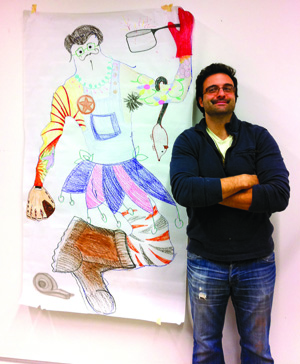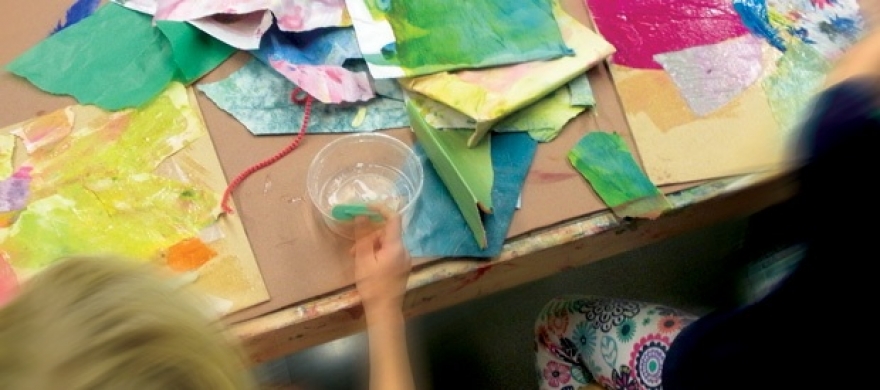“Kaya” was just 8 years old when recurrent domestic violence forced her from home in Bangkok, Thailand, into a nongovernmental children’s agency nearby. Craving the bond between parent and child, she formed atypical attachments to adults there and exhibited aggressive and confrontational behavior to those her own age.
When Celine Crespi-Hunt, Kaya’s art therapist and a doctoral student at the Pepperdine
Graduate School of Education and Psychology (GSEP), asked the youngster and her peers
to create self-representational flowers for their community garden, Kaya made a lotus
flower, which only blooms in water. Her unique creation could not be “planted” in
dirt alongside the other children’s, so the group came together to build a small pond
next to the garden where Kaya’s lotus could be displayed.
The process of creating the lotus and watching it buoy in the pond helped Kaya connect
with the other children and experience the sense of community that she lacked in her
home life. More importantly, it paved the way for a meaningful breakthrough. Today
art therapists worldwide, including Crespi-Hunt and other GSEP students and alumni,
are using such creative activity to foster self-expression, open communication, and
confidence in their clients. Their combination of traditional psychotherapy techniques
with art creation helps open a variety of individuals through alternative means of
expression.
“The idea of art therapy is for a client to express themselves in a way that is different
than just talking about things and answering questions,” explains Crespi-Hunt. “They
can look at their artwork and gain insight through what they created, talk about the
image that they made, and the process of making art and what that felt like. Even
materials can evoke different emotions and can mean a lot to people.”
In a typical session, an art therapist provides the materials and therapeutic space
to encourage the art-making process and determines the appropriate materials for each
individual client. Using art as therapy not only allows patients to create something
that is unique to themselves, but also provides tangible evidence of the healing process.
“This type of therapy provides a record or visual narrative of a person's experience
and shows the progress and legacy of the therapeutic work,” adds Crespi-Hunt.
Often utilized to treat existing conditions, as in Kaya’s case, art therapy also nurtures
avenues of expression in typically developing children. In his private practice as
a marriage and family therapist, alumnus Peter Tulaney (MA '05) uses art in classic
projective identification techniques that allow clients to access subconscious thoughts
and feelings through guided illustrations.
The approach can be applied in a nonclinical setting as well, like at the Malibu Art
Barn, Tulaney’s therapeutic art workshop, where art is used to promote healthy social
and emotional development. “We practice under the theory that creativity is one of
the paramount features of early childhood development,” he explains. “Without creative
outlets, the kids are stifled in how they become free and creative thinkers.” Tulaney’s
workshop also features the “Artworking” program for younger children, which is designed
to facilitate socialization and collaborative problem solving through creative media.
“We use art because young children lack the language development to express themselves
in meaningful or satisfactory ways.”

Peter Tulaney (MA '05)
Although art therapy can prove to be a highly effective process, the approach still
has its own challenges to overcome and skeptics to convince. Some of the biggest skeptics
are patients and clients themselves, who feel reluctance rooted in self-consciousness.
“A lot of people, and especially children, view art as wall-hangings or images they
see in books,” says Tulaney. “It’s rare that you see a young person willing to create
something and not feel that they’re going to be judged or critiqued on what they’re
doing.” The problem is the assumption that the practice is meant to encourage both
cognitive and artistic proficiency. “Whether they become artists is not my concern.
The time that we spend is about the process of creating art, not the final product.”
Art therapy suffers as well from the common misconception that it is generally geared
towards non- or preverbal children and adolescents. In fact, the approach can offer
a powerful alternative to traditional therapy in adults who have trouble communicating
or have encountered difficulty with talk therapy.
That’s something that doctoral candidate Jennifer Brown learned while working with
an elderly, former drug addict afflicted with terminal HIV at the Robert Mapplethorpe
Residential Treatment Facility in New York. “He didn’t want any part of it. He would
only comply for a couple of weeks and only write poetry,” says Brown. “I would encourage
him that it’s not about what you can draw or what you can’t draw. It’s about getting
it out in an artistic way.”
After a few weeks, the patient eventually picked up a pencil. “You could see the fear
of selling into art therapy and what that would expose, whether it was a lack of talent
or an unwillingness to break down his barriers.” What began as basic black-and-white
sketches of animal faces he had found in National Geographic magazines developed into
impressive full-color paintings. “His mode of expression increased, which led to improved
communication. He was never overly talkative, but I noticed his evolution through
art, and it created a new space for him to express himself and relieve his stress.”
The adaptability of art therapy is precisely what intrigued Kimberly Smith (MA ‘08),
a doctoral candidate who recently cofacilitated the eight-week Express Yourself Group
program led by Thema Bryant-Davis, art and expressive therapy expert and associate
professor of psychology at GSEP. The program provided therapy to children of severely
underserved populations at a domestic violence shelter in Los Angeles and encouraged
the creation of art through reading poetry, making music, building collages, and exploring
other creative modes. “Even though these kids were getting talk therapy and had multiple
social workers, they didn’t really have an outlet for themselves,” explains Smith.
While treating the children of afflicted parents, Smith also found art therapy able
to meet the needs of diverse age groups. She modified the foundation of what she learned
as part of the Express Yourself Group and utilized similar techniques in treating
the patients of the adult rehabilitative psychology unit at the Long Beach VA hospital,
where she currently works. “Many adults are disabled in capacities where they have
functional impairments or limited mobility. We have adapted the equipment and techniques
used with the children so that adults may also express themselves through art.”
Perhaps one of the greatest benefits of art therapy is its opportunity to extend far
past the time frame of treatment and continue throughout the patient’s life. “Treatment
does not simply end with the creation of a picture,” Smith notes. “The beauty of art
therapy is in a patient’s ability to go back and reexamine their work to evoke different
thoughts, memories, and emotions that will help them develop long-term coping skills.”
